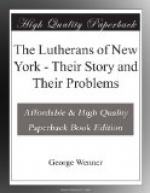[illustration: “Gottlob Frederick Krotel, D.D., LL.D.”]
In 1867 another synodical split took place. The
New York Ministerium separated from the General Synod
on confessional grounds and took part in the organization
of the General Council. Thereupon most of the
English-speaking members, occupying a milder confessional
basis, left the Ministerium, formed the Synod of New
York and united with the General Synod.*
The author’s
connection with the work in New York began about this
time. After graduation at Yale College in 1865,
he found employment in a New York library, and soon
after matriculated as a student in Union Theological
Seminary. The needs of Protestant Germans on the
East Side attracted him into mission work which resulted
in the formation of a congregation of which he took
pastoral charge upon his ordination by the Synod of
New York, October 19th, 1868.
The lines of three synodical bodies, General Council. [sic] General Synod and Synodical Conference, that is “Missouri,” were now distinctly drawn and for the rest of the century the relations of Lutheran ministers and churches were sharply defined. Ministers were kept busy in explaining the differences, but it is to be feared that some of the laymen did not always understand.
In 1868 members of St. James Church, who sympathized with the attitude of the General Council in favor of a stricter confessional basis, organized a new English congregation, Holy Trinity, of which Dr. Krotel became the first pastor. Dr. Wedekind was called to St. James. Both men, pastors of English congregations, had come from Germany in their early youth, were educated in American schools and were thoroughly acquainted with American institutions. For a generation these two men, each in his own sphere, on opposite sides of a high synodical fence, contributed much to the growth and progress of the churches in this city.
Immigration from Lutheran lands continued to increase and reached its high water mark in this period.
Prior to 1867 there were few Swedes in New York. In 1870 they numbered less than 3,000. The immigrants were chiefly farmers who settled in the West. In 1883 large numbers began to come from the cities of Sweden and these settled in the cities of the East. In 1900 the census credited New York with 29,000 Swedes. In 1910, including the children, there were 57,464, of which 56,766 were Protestants.
The first Swedish Lutheran church was organized in 1865 by Pastor Andreen who had been sent here for this purpose by the Augustana Synod. Among the first trustees was Captain John Ericsson, the inventor of the Monitor. Its first pastor was Axel Waetter, a cultured minister of the Swedish National Church.
At present there are fourteen Swedish Lutheran churches in New York reporting a membership of 8,626 souls.
An Immigrant House in Manhattan, a Home for the Aged and an Orphans’ Home in Brooklyn, and Upsala College in Kenilworth, N. J., represent the institutional work of the Swedish Lutherans.




